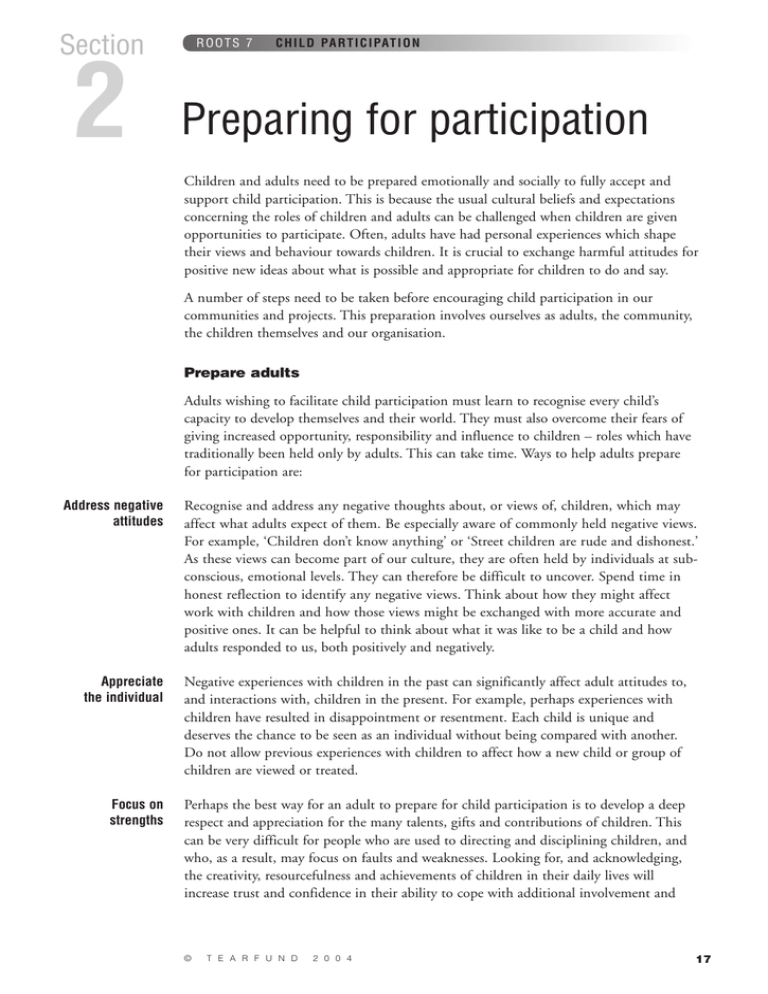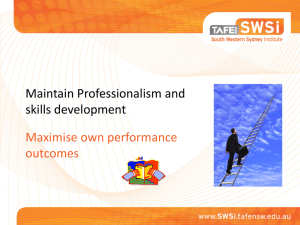2 Preparing for participation Section
advertisement

Section 2 ROOTS 7 C H I L D PA RT I C I PAT I O N Preparing for participation Children and adults need to be prepared emotionally and socially to fully accept and support child participation. This is because the usual cultural beliefs and expectations concerning the roles of children and adults can be challenged when children are given opportunities to participate. Often, adults have had personal experiences which shape their views and behaviour towards children. It is crucial to exchange harmful attitudes for positive new ideas about what is possible and appropriate for children to do and say. A number of steps need to be taken before encouraging child participation in our communities and projects. This preparation involves ourselves as adults, the community, the children themselves and our organisation. Prepare adults Adults wishing to facilitate child participation must learn to recognise every child’s capacity to develop themselves and their world. They must also overcome their fears of giving increased opportunity, responsibility and influence to children – roles which have traditionally been held only by adults. This can take time. Ways to help adults prepare for participation are: Address negative attitudes Recognise and address any negative thoughts about, or views of, children, which may affect what adults expect of them. Be especially aware of commonly held negative views. For example, ‘Children don’t know anything’ or ‘Street children are rude and dishonest.’ As these views can become part of our culture, they are often held by individuals at subconscious, emotional levels. They can therefore be difficult to uncover. Spend time in honest reflection to identify any negative views. Think about how they might affect work with children and how those views might be exchanged with more accurate and positive ones. It can be helpful to think about what it was like to be a child and how adults responded to us, both positively and negatively. Appreciate the individual Negative experiences with children in the past can significantly affect adult attitudes to, and interactions with, children in the present. For example, perhaps experiences with children have resulted in disappointment or resentment. Each child is unique and deserves the chance to be seen as an individual without being compared with another. Do not allow previous experiences with children to affect how a new child or group of children are viewed or treated. Focus on strengths Perhaps the best way for an adult to prepare for child participation is to develop a deep respect and appreciation for the many talents, gifts and contributions of children. This can be very difficult for people who are used to directing and disciplining children, and who, as a result, may focus on faults and weaknesses. Looking for, and acknowledging, the creativity, resourcefulness and achievements of children in their daily lives will increase trust and confidence in their ability to cope with additional involvement and © T E A R F U N D 2 0 0 4 17 2 Preparing for participation ROOTS 7 C H I L D PA RT I C I PAT I O N responsibility. Adults who concentrate on strengths and accomplishments allow and support children to participate more fully Reflection ■ What negative attitudes do I have towards children? ■ What is the source of these attitudes? ■ What are the consequences of these attitudes? ■ How can I address these attitudes? ■ What practical steps could I take? ■ What strengths do I see in individual children I know? ■ How can I support them to develop their strengths? Prepare the children Participation requires children to share their ideas, opinions and feelings openly and honestly. We need to create an environment in which they feel safe and confident to do this before they can take action. Some ways of doing this are: Develop positive relationships Positive, trusting relationships between children and adults are important for genuine participation. They encourage open communication and supportive partnerships. Spend time developing positive relationships with children, beginning with fun games and activities that allow opportunities for light-hearted interaction. This creates shared memories that can help to strengthen future relationships. Allow space for meaningful conversations that will allow children and adults to get to know each other on a more personal level. Look for common interests and experiences that will encourage bonding. Ideas for activities that help build relationships ■ Team sports such as football, volleyball or frisbee. ■ Short trips to museums, tourist sites and other fun places. ■ Group games, such as: DELIVERING MAIL The group sits in a circle. All the chairs should be occupied and one person stands in the middle. The person in the middle says, ‘I am delivering mail to everyone who has…’ Then they name a characteristic, such as long hair, glasses or blue trousers. Anyone who has that characteristic must stand up and run to a different seat, while the person in the middle also tries to find a seat. The person left without a seat becomes the person who delivers mail and the game starts again. REPORTERS In pairs, the children give their names and other information about themselves to their partner. For example, what they had for breakfast, their favourite animal, food and so on. After two or three minutes everyone comes back together and reports what they found out about their partner to the group. This game can be used to introduce new people. Children can also be given a question to answer during their discussion to introduce an issue which will be discussed later in a session. 18 T E A R F U N D R O O T S R E S O U R C E S 2 Preparing for participation Promote understanding Gain agreement ROOTS 7 C H I L D PA RT I C I PAT I O N Children cannot respond meaningfully to social issues unless they are first given the opportunity to learn about, and understand, them. Ignorance is a barrier to participation, while knowledge can result in good participation. Take time to inform children of the issues affecting their lives by organising workshops or other learning events. Allow children to reflect on, and respond to, the information presented by sharing their views with each other in small groups, and later with adults. Peer education (child-to-child) is also an effective way for children to receive and exchange information and views with one another and become interested in social issues. Ideally children should set the agenda. However, as we start to encourage child participation it is crucial to gain children’s support and commitment. Without their agreement, children can feel as if they are being manipulated or even deceived. If we gain their agreement, children will be more committed to participating, especially in the long term. Inform children of their roles before beginning an activity. Recognise that vulnerable children will often be giving up time and income-generating opportunities in order to participate. Be aware of this and ensure that their participation can fit around their work activities. If possible, ask them how they want to be involved and help them plan their own roles. Make clear what children and adults are expecting of the project and each other and ensure these expectations are realistic and agreed to by everyone. Reflection ■ What games have we used with children that helped to build relationships? ■ Can we think of any that we could start to use? ■ What planning might be needed? ■ What activities could we do with children that will allow conversations to take place? ■ What creative ways can we think of to share information with children? ■ How might these methods need to be different from those we use with adults? Prepare the wider community Culture and tradition can provide barriers to child participation. Children often provide childcare, labour and income in many households, but find it hard to share their views. Schools and churches may provide children with opportunities to participate in clubs, youth groups and other activities. However, these are usually designed for children rather than with them. Effective ways to raise awareness in the community about the value of children’s participation include: ■ Sharing the results of research undertaken by children with the community leaders ■ Inviting community leaders, parents, teachers, church leaders and other members of the community to an official opening or presentation made by the children for something that they have achieved together © T E A R F U N D 2 0 0 4 19 2 Preparing for participation ROOTS 7 ■ C H I L D PA RT I C I PAT I O N Adults and children doing Participatory Learning and Action (PLA) activities together. The case study below shows that the children had some concerns that were different to those of the adults. The children focused on specific issues that affected their daily lives, such as their ability to study and the lack of a meeting place. The exercise challenged the CASE STUDY Stephenson (1998a) Adults and children in a village in South India came together to discuss issues facing children in their community. The village members divided into three groups: men, women and children. Each group was asked to answer three questions and record the answers on a large sheet of paper. A literate member of the group wrote down comments. The questions were: ■ What do children contribute to the village? ■ What problems do children have? ■ Why do they have these problems? The answers from the groups were written on a large sheet of paper. The results are summarised in the table below. Questions Men’s answers Women’s answers Children’s answers What do children contribute to the village? • Shramadan* • Shramadan • Shramadan • Tree planting • Entertainment • Support to orphans • Beekeeping • Learn signature • Beekeeping • Construction of the • Children’s daily activities community centre What • Poverty problems do • Illiteracy children have? • Infrequent transport • Pray for rain • Poverty • Hard to get to school • Lack of school materials • No playground • Infrequent transport • Infrequent transport • Too many children • Too many children • Low voltage lights – • Bad health • Bad health • Broken water pump • Broken water pump difficult to study at night • Bad health • Carrying water • No place to meet Why do they have these problems? • Partial employment • Partial employment • Road not maintained • No family planning • No family planning • Village will not give land • No ‘voice’ for the village • No ‘voice’ for the village • No government response • No government response • Poor sanitation * Shramadan means a collective village self-help activity 20 T E A R F U N D R O O T S R E S O U R C E S for playground • No resources 2 Preparing for participation ROOTS 7 C H I L D PA RT I C I PAT I O N adults: ‘Now we know what the children need,’ one man commented at the end of the session. ‘We have more awareness about children’s problems. It’s good to include them so we know.’ Reflection ■ What traditions and cultural views might be barriers to child participation in our communities? ■ In what ways can we raise awareness about the need for child participation in our communities? Prepare our organisation If we want children to participate more in the communities in which we work and the projects we carry out, we may need to make changes within our organisation to ensure that our structures and staff support child participation. Child protection The organisation should have a child protection policy in place before members of staff work with children. Ideally all members of staff who have contact with children during the course of their work should attend training about child protection. Guidelines for good practice have been developed by Tearfund and are given in the Appendix. Staff training In addition to child protection training, members of staff should be trained in how to communicate, and work in participatory ways, with children. This book contains many ideas that could be shared with members of staff in a workshop setting. Decisionmaking and organisational structure By involving children, we will challenge the way the organisation makes decisions and manages its work. Decide how child participation will affect the way that the organisation makes policies, does advocacy work, recruits staff and reviews programmes. Children’s involvement in all these issues will ensure that the organisation becomes one that works with, rather than for, children. Reflection ■ Do we have a child protection policy? If not, where can we get information and help to write one? ■ What key issues should training in child protection address? ■ Should we consider providing training for our staff about how to work with children? Do we know someone who could provide this training? What key issues should the training address? ■ To what extent do children participate in decision-making in our organisation? How can we provide opportunities for them to participate more in the work of our organisation? What barriers might need to be broken down? © T E A R F U N D 2 0 0 4 21 2 Preparing for participation ROOTS 7 C H I L D PA RT I C I PAT I O N Preparation checklist Prepare adults ■ Recognise and address any negative attitudes towards children ■ Recognise each child as an individual ■ Recognise children’s strengths as well as weaknesses ■ Develop positive relationships with children ■ Promote understanding by informing children of social issues ■ Agree with children their roles and expectations for their involvement Prepare the wider community ■ Raise awareness about the benefits of child participation ■ Enable children to present their ideas and activities at a church service or other community gatherings Prepare our organisation ■ Child protection policy and training ■ Train staff in how to communicate with children ■ Think about how child participation will affect the way the organisation works Prepare the children Reflection ■ What are the key issues to be aware of when preparing for children’s participation? ■ Why is it so important to prepare carefully if children are to participate effectively? 22 T E A R F U N D R O O T S R E S O U R C E S







